Uzbekistan
Things to DO
Shakhrisabz
Formerly known as Kesh ("heart-pleasing") and tentatively identified with the ancient Nautaca, Shakhrisabz is one of
Central Asia’s most ancient cities.
It was founded more than 2.700 years ago and formed a part of the Achaemenid Empire or Persia from the 6th to 4th centuries BC.
Throughout this period Kesh remained an important urban center of Sogdiana, a major province within the Empire. Documents from the late
Achaemenid period speak of the renovation of the city's walls. Its name was officially changed to Shahrisabz in the modern era.
Alexander the Great's general Ptolemy captured the satrap of Bactria and pretender to the Persian throne, Artaxerxes V , at
Nautaca (329 BC) thus ending the once great Achaemenid Empire.
Alexander the Great chose to spend his winters and met his wife Roxanna in the area in 328-327 BC.
Between 567 and 658 AD rulers of Kesh paid taxes to khagans of Turkic and Western Turkic khaganates. In 710 the city was conquered by the
Arabs and following the Mongol conquest of Khwarezmia in the 13th century, the region came under the control of the Barlas tribe, all
of whose lineages seem to have been associated with this region.
Kesh was the birthplace of Timur in 1336, to the family of a minor local Barlas chief, and during the early years of the Timurid
Dynasty (1370-1507), the city enjoyed his considerable patronage. Timur regarded Kesh as his “home town” and planned it eventually to
be the location of his tomb. However, during his reign, the center of activity shifted to Samarkand instead.
According to legend, the Khan of Bukhara, Abdullah Khan II (r 1583 - 1598) had the city destroyed in a fit of rage over the death
of his favorite horse from exhaustion on a steep approach to the city, but was later overcome with remorse for the damage he had done.
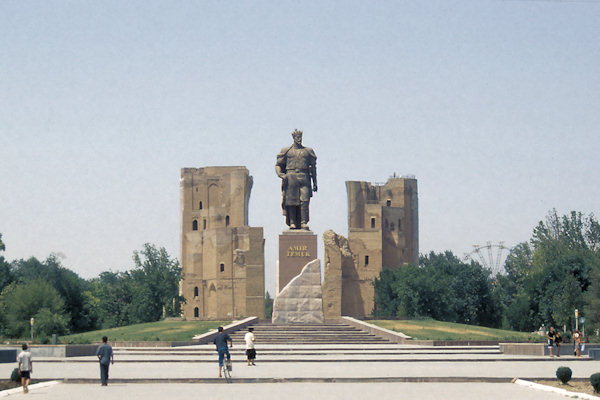 |
|||||
The city struggled for autonomy under Bukharan rule and the Russians helped the Bukharan emir conquering the city in 1870.
Ak-Saray Palace; Timur's Summer Palace (“White Palace”) was planned as the most grandiose of all Timur's constructions. It
was started in 1380 by artisans deported by Timur from the recently conquered Khwarezm. Unfortunately, only parts of its gigantic 65 m
gate-towers survive, with blue, white and gold mosaics.
Above the entry of the Ak-Saray are big letters saying: "If you challenge our power – look at our buildings!"
The Kok Gumbaz Mosque was completed by Ulugh Bek in 1437 in honour of his father Shah Rukh (who was Timur's son). The name
means "Blue Dome", though the luminous outer tiles are long gone and it's full of pigeons now. It appearve to be under
snail's-pace restoration.
Also of interest are medieval baths and an 18th-century bazaar.
Samarkand
Samarkand ("Marakanda" to the Greeks), one of Central Asia's oldest settlements, was probably founded in the 5th century AD.
It was already the cosmopolitan walled capital of the Sogdian Empire when it was taken in 329 AD by Alexander the Great,
who said: "Everything I have heard about Marakanda is true, exept that it's more beautiful than i ever imagined"
From the 6th to the 13th centuries it grew into a city more populous than today, changing hands every couple of centuries: Western
Turks, Arabs, Persian Samanids, Karakhan and Seljuq Turks, Mongolian Karakitay and Khorezmshah have all ruled here - before being
literally obliterated by Genghis Khan in 1220.
This might have been the end of the story, but in 1370 Timur decided to make Samarkand his capital and over the next 35 years
forged a new, almost-mytical city, Central Asia's economic and cultural epicentre.
His grandson Ulugh Bek ruled until 1449 and made it an intellectual centre as well.
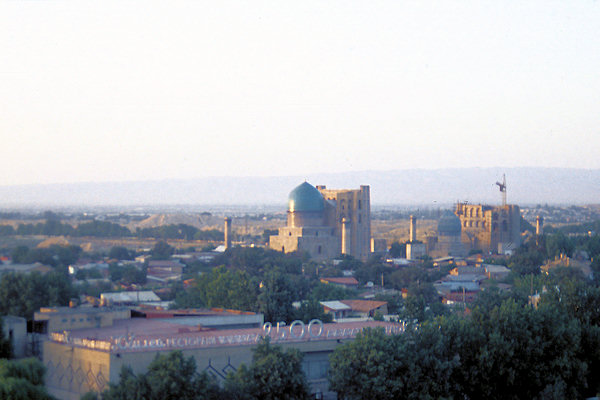 |
|||||
When the Uzbek Shaybanids came in the 16th century and moved their capital to Bukhara, Samarkand went into decline. For several
decades in the 18th century, after a series of earthquakes, it was essentially uninhabited.
The Emir of Bukhara forcibly repopulated the town towards the end of the century, bit it was only truly resucitated by the Russians,
who forced its surrender in may 1868 and linked to the Russian empire by Trans-Caspian Railway 20 years later.
The ancient Hazrat Hyzr Mosque got its name in honor of the legendary saint and eternal pilgrim Hazrat Hyzr, the cult of which
goes back to pre-Islamic times.
Hazrat Hyzr considered as a saint, symbolizing life and immortality; as a patron of travelers, bringing luck in trade.
It was destroyed during the invasion of Genghiz Khan in 1220, but the place has always been esteemed as holy place and in the 19th century
a new mosque was erected on the ancient foundation.
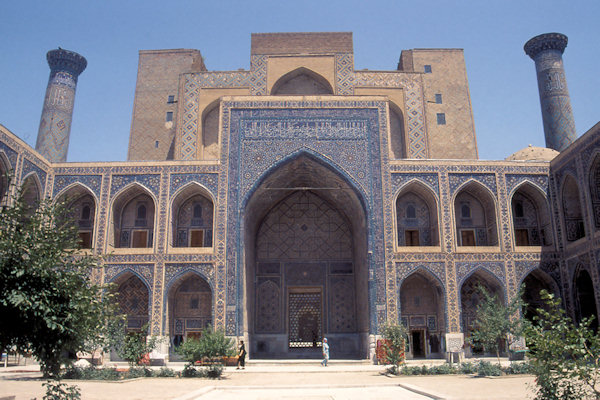 |
|||||
The Registan; This ensemble of majestic, tilting medrassas - a near overload of majolica, azure mosaics and vast,
well-proporitioned spaces - is the centrepiece of the city and one of the most awesome single sights in Central Asia.
It was medieval Samarkand's commercial centre and the plaza was probably a wall-to-wall bazaar.
Ulugh Bek Medrasa on the west side is the oldest, finished in 1420 under Ulugh Bek (who is said to have taught mathematics there;
other subjects included theology, astronomy and philosophy).
The other buildings are imitations by the Shaybanid Emir Yalangtush Bakhodur.
The entrance portal of the Sher-Dor Madrasa, opposite Ulugh Bek's and finished in 1636, is decorated with raring felines that look
like tigers but are meant to be lions, flouting Islamic prohibitions against the depiction of live animals.
In between is the Tilya-Kori Madrasa, completed in 1660, with a pleasant, garden-like mosque courtyard.
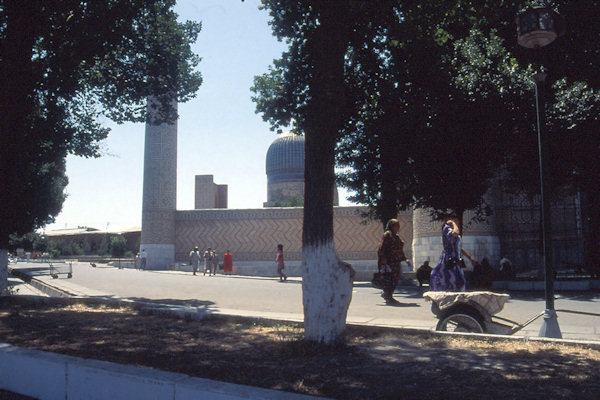 |
|||||
After his Indian campaign in 1399 Timur decided to undertake the construction of the gigantic Bibi Khanym Mosque in his new
capital, Samarkand. When Timur returned from his military campaign in 1404 the mosque was almost completed.
From the beginning of the construction, problems of structural integrity of the structure revealed themselves. Various reconstructions
and reinforcements were undertaken in order to save the mosque. However, after just a few years, the first bricks had begun to fall out
of the huge dome over the mihrab.
After that, the mosque slowly deteriorated and became a ruins gnawed at by the wind, weather, and earthquakes.
The inner arch of the portal construction finally collapsed in an earthquake in 1897.
A first basic investigation into securing the ruins was made in Soviet times. Late in the 20th century, the Uzbek government began
restoration of three dome buildings and the main portal.
 |
|||||
Amir Timur Haykali; This glowering statue of Timur seated on his throne marks the boundary between the old Uzbek town and
the Russian-designed new town.
The Guri Amir Mausoleum (Persian for "Tomb of the King") is surprisingly modest mausoleum topped by a fluted azure dome.
One reason it looks small is that a medrassa that used to be in front is now gone, exept the gate.
Timur was laid to rest alongside his grandson Muhammad Sultan in the shrine's central chamber.
In time, Timur's own tomb was boxed in by three more graves—those of his spiritual adviser, Sayyid Baraka (1343-1403); his
grandson Ulugh Beg (1394-1449), the famous astronomer king; and one of his sons, Shah Rukh Mirza (1377-1447), the second
ruler of the Timurid empire.
With these additions, along with the graves of several more relatives, the tomb was transformed into the dynastic mausoleum of the
Timur dynasty.
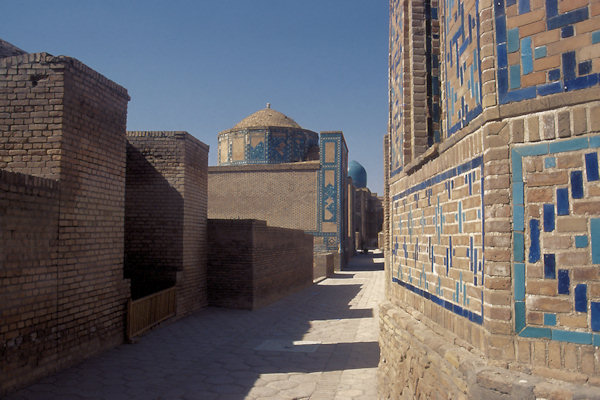 |
|||||
The name Shah-i-Zinda, which means "The Living King", refers to its original, innermost and holiest shrine - a complex of
cool, quiet rooms around what is probably the grave of Kusam ibn Abbas, a cousin of the Prophet Mohammed who is said to have
brought Islam to this area in the 7th century.
This is among the oldest standing buildings in the city and it's also an important place of pilgrimage.
The earliest tombs are those at the north of the site, which date from the second quarter of the 14th century when the site was revived
following the city's sacking by the Mongols. The tiles used here are made from a terracotta base that has been painted blue-green or
blue-grey prior to being glazed and fired.
The latest group of tombs are to the south of the site. These were built at the time of Ulug Beg and include the tomb of Timur's nurse.
The summer mosque and small madrassa either side of the entrance gateway are from the 19th century, so relatively recent additions.